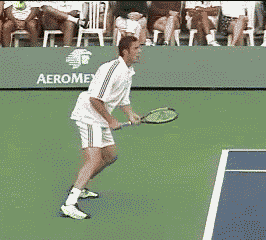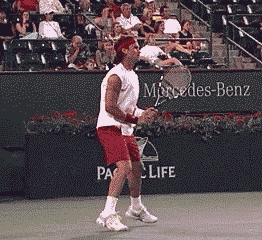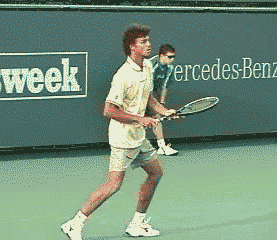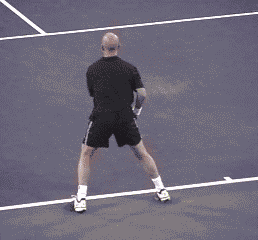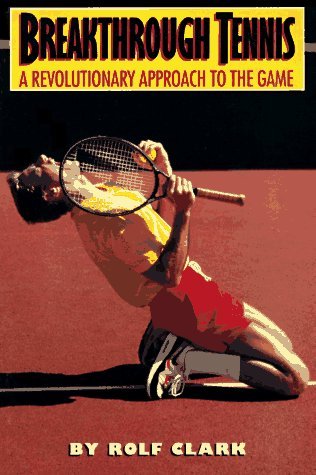|
TennisOne Lessons Basics to Build On Rolf Clark Certain mechanics should be built into a player's muscle memory. They include hitting out in front, making the ball rise (so it clears the net), stepping into the ball, hitting through the ball, and controlling the backswing. Novice and intermediate players should pay attention to these basics as they explore more complex things, like balance and timing, power hitting, and concentration.
Hitting out in front It's important that your racquet meets the ball at the right position relative to your body. You hit at the wrong place if you meet the ball too early or too late. Few players hit too early, so we'll skip that. Hitting late, however, is a very common mistake. It means meeting the ball when it's past the optimum contact point. The right place to hit is out in front of your torso, wherever it is facing at impact. Think of the way you swing – this applies to any stroke. At the instant the racquet hits the ball your torso will be facing in some direction. The direction your torso faces – specifically where your breastbone is facing – is where "out in front" is for you. If you turn sideways to the net to hit, then at impact your breastbone will face more toward the sideline, and the sideline will be in the direction of "out in front." If you are turned not quite so far, and you're facing one of the net-posts, then the net-post will be in the direction of "out in front." The definition even applies to taking a ready stance facing directly toward the net. If you watch “open stance” hitters, you'll see that as they execute their swing they twist their shoulders about 90-degrees back in the wind up and then make contact with their breastbone facing toward the netpost. At impact the ball is "out in front" of them – that is, where the breastbone faces. In front of your breastbone is where you can see the ball best. It's where your eyes are used to looking, like when you're reading a book. Make the ball rise Hitting the ball out in front doesn't guarantee that it will clear the net after you hit it. You also need to make the ball rise when you hit it. Most intermediates hit balls that barely clear the net and land short. This allows their opponents to move in toward the net and put the ball away.
How much the ball rises, where it lands, and what kind of bounce the ball takes depends on two factors: the tilt of your racquet face and the way you swing your racquet. These also determine the type of spin the ball takes. If the racquet is tilted slightly upward and then is driven to slide slightly under the ball, the ball will rise with under-spin. The upward tilt deflects the ball upward to easily clear the net . You can also make the ball rise by using topspin. You get topspin by having the racquet face perpendicular to the ground while driving it upward through the ball at impact. The upward swipe makes the ball rise and land deep in your opponent's court. But topspin is a two-edged sword. It takes more energy to hit with topspin than it does with no spin or with under-spin. To get topspin you need to drive upward with your legs, which means bending your knees. The down-to-up knee action takes energy. Hitting with topspin time after time requires strong legs. As one ages, generating topspin gets more difficult. In the National 60 championships you will see much less topspin than in matches for younger age groups. The best senior players use efficient strokes with little topspin. Young, stronger players can afford the extra energy required by extreme topspin. Whatever stroke you use, the ball needs to be lofted to clear the net. Move toward the ball to hit We're better at moving forward than we are at moving sideways or backward. You're far quicker and you react faster if you move forward to intercept a hard hit ball as it approaches. As you move forward, intercept the ball with your racquet. Be determined to meet the ball no matter where or how hard it is hit. But make sure your racquet is well out in front of you when you make contact. This usually means restricting your backswing to shorten your reaction time.
Sometimes you will be moving sideways before you hit, as in baseline groundstrokes. Still, stepping into the ball just before impact will put more power into your return. You may need to experiment with this a bit. Practice getting your swing to include stepping into the ball. Hit through the ball One of the most important elements in hitting well is to hit through the ball. Too many players simply meet the ball. That's not enough. Hitting through the ball means to drive the racquet's sweet-spot well beyond the impact point. A good deal of the swing should occur after the impact. You hit through the ball by accelerating the racquet through the impact point. Envision your swing arc. Think of pulling the racquet through so that more than half of the swing arc occurs after the impact point. Use a shorter backswing for timing, control, and power One of the first lessons a beginner usually learns is to bring the racquet back before swinging -- way back. When he finally swings he is supposed to make a wide arc that stretches from his extended racquet behind him, through the ball, to follow-through well out in front. That type of swing takes a lot of time and costs you power. A boxer would never swing that way. He'd use a short, swing that uses his body to generate power. The same is true in tennis. Consider developing a more compact swing. Bring the racquet hand back only to your hipbone, then launch the racquet forward using your whole body as you step into the ball. Think of driving a large nail into the side of a fencepost. The nail is waist high and you're swinging a hammer to hit the nail-head. If you take the hammer back in a very long arc behind you and then swing it forward, you'll almost surely miss the nail.
On the other hand if you bring the hammer back in a shorter, compact arc and then drive it forward, you'll usually hit the nail squarely. If you swing with your whole torso, and not just your arm, you then will add your body's momentum to the hammer's weight. Then each accurate hit will be more powerful. It's the same when you hit a tennis ball. A short, compact swing of the body is more accurate and more powerful than a long, loose swing of the arm from the shoulder. Develop your swing so it's compact. Putting It All Together Think of tossing a 10-pound sack of potatoes from the ground into the back of a pickup truck. You hold the sack with two hands, bring it back a little, step forward and release it in front of your torso with an upward motion. That motion includes most of the basics of a forehand tennis swing. Just substitute your racquet for the sack of potatoes. In a good swing you hold the racquet in front of you, bring it back a little, step into the ball as you drive the racquet through the ball, meeting the ball out in front. You would not bring the sack of potatoes way back behind you to toss it. Instead, you'd bring it back about to your thigh and then step forward to get launching power as you throw. That's the way to get power into your shots, too. Your comments are welcome. Let us know what you think about Rolf Clark's article by emailing us here at TennisOne.
|

